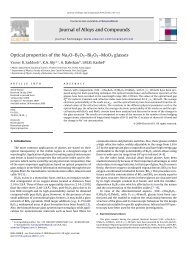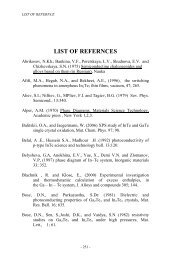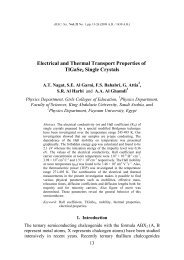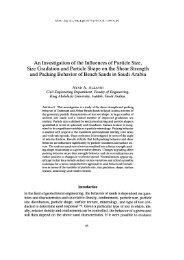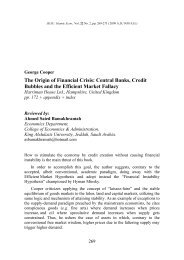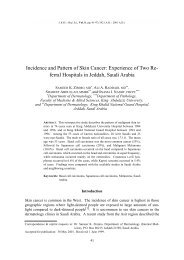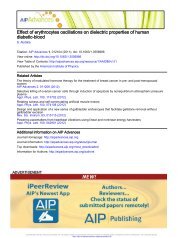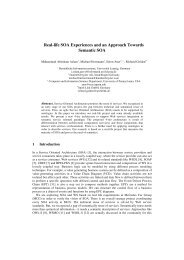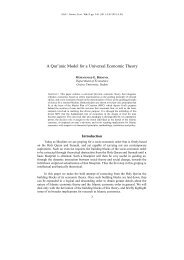On Some Applications of New Integral Transform âELzaki Transformâ
On Some Applications of New Integral Transform âELzaki Transformâ
On Some Applications of New Integral Transform âELzaki Transformâ
You also want an ePaper? Increase the reach of your titles
YUMPU automatically turns print PDFs into web optimized ePapers that Google loves.
18 Tarig. M. Elzaki et al<br />
Pro<strong>of</strong><br />
−at<br />
We have, by definition ⎡ ( )<br />
∞<br />
0<br />
( 1+<br />
)<br />
au t<br />
u<br />
( )<br />
Ε ⎣e f t ⎤<br />
⎦ = u∫ e f t dt . Let<br />
−<br />
u<br />
w = or<br />
1 + au<br />
w<br />
u = , we have:<br />
1 − aw<br />
∞ a<br />
∞ t<br />
−<br />
w −<br />
1 1<br />
u<br />
w<br />
⎡ u ⎤<br />
u∫e f () t dt = e f () t dt = T ( w)<br />
= T and<br />
1−aw ∫<br />
1− aw au ⎢1<br />
0 0<br />
1<br />
au ⎥<br />
− ⎣ + ⎦<br />
1+<br />
au<br />
−at<br />
u<br />
Ε ⎡<br />
⎣e f () t ⎤<br />
⎦ = ( 1+<br />
au)<br />
T<br />
1+<br />
au<br />
Theorem (5)<br />
−<br />
u<br />
If Ε ⎡⎣f ( t) ⎤⎦ = T ( u),<br />
then: Ε⎡⎣f ( t −a) H ( t − a) ⎤⎦<br />
= e T ( u)<br />
Where H ( t − a)<br />
is Heaviside unit step function.<br />
Pro<strong>of</strong><br />
It follows from the definition that:<br />
∞<br />
a<br />
−<br />
−<br />
u<br />
u<br />
( ) ( ) ⎤ ( ) ( ) ( )<br />
Ε⎡f t−a H t− a = u e f t−a H t− a dt = u e f t−a dt<br />
⎣ ⎦ ∫ ∫<br />
Let t a τ ,<br />
0 0<br />
a ∞ t a<br />
− − −<br />
u<br />
u<br />
τ<br />
− = then we have: e u e f ( τ) dτ<br />
= e T( u)<br />
∫<br />
0<br />
2<br />
In particular if f ( t ) = 1, then: H ( t a) u e − u<br />
Ε⎡⎣ − ⎤⎦<br />
=<br />
Also we can prove by mathematical induction that:<br />
n−1<br />
⎡<br />
a<br />
( t−<br />
a)<br />
⎤<br />
−<br />
n+<br />
1 u<br />
Ε⎢<br />
H ( t− a)<br />
⎥ = u e<br />
⎢ Γ( n<br />
⎣<br />
) ⎥⎦<br />
Example (1) (Linear dynamical systems and signals)<br />
In physical and engineering sciences, a large number <strong>of</strong> linear dynamical systems<br />
with a time dependent input signal f ( t ) that generates an output signal x ( t ) can be<br />
described by the ordinary differential equation with constant coefficients.<br />
n n−<br />
( 1 m m−<br />
D + a ) ( ) ( 1<br />
n−1D + ... + a0 x t = D + bm−<br />
1D + .... + b0) f ( t)<br />
(1)<br />
d<br />
Where D = , a0, a1,... an−<br />
1<br />
, b0, b1,...<br />
bm−<br />
1<br />
are constants<br />
dx<br />
We apply ELzaki transform to find the output x ( t ) so that (1) becomes.<br />
P ( u) x ( u) R ( u) q ( u) f ( u) s ( u)<br />
− = − (2)<br />
n n−1 m m−1<br />
a<br />
a<br />
∞<br />
t





